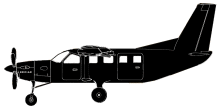
ASN Wikibase Occurrence # 191977
This information is added by users of ASN. Neither ASN nor the Flight Safety Foundation are responsible for the completeness or correctness of this information.
If you feel this information is incomplete or incorrect, you can submit corrected information.
| Date: | Monday 12 December 2016 |
| Time: | 05:37 |
| Type: |  Quest Kodiak 100 |
| Owner/operator: | Redtail Air |
| Registration: | N772RT |
| MSN: | 100-0140 |
| Year of manufacture: | 2015 |
| Total airframe hrs: | 504 hours |
| Engine model: | P&W Canada PT6A-34 |
| Fatalities: | Fatalities: 1 / Occupants: 1 |
| Aircraft damage: | Destroyed |
| Category: | Accident |
| Location: | Grand County near Moab, UT -
 United States of America United States of America
|
| Phase: | Initial climb |
| Nature: | Unknown |
| Departure airport: | Moab, UT (CNY) |
| Salt Lake City, UT (SLC) | |
| Investigating agency: | NTSB |
| Confidence Rating: |
The commercial pilot was departing on a routine positioning flight in dark night visual meteorological conditions. Footage from a security camera at the airport showed the airplane take off normally and initiate a right turn, which was the established direction of traffic for the takeoff runway. The airplane continued the right turn, then entered an increasingly rapid descent and subsequently impacted terrain about 1 mile southwest from the airport. The wreckage distribution was consistent with a high-energy impact. Examination of the airframe and engine revealed no evidence of any preimpact mechanical malfunctions or anomalies that would have precluded normal operation.
Autopsy and toxicology testing of the pilot did not reveal any evidence of impairment or incapacitation. Visual conditions prevailed in the area at the time of the accident; however, the setting Moon was obscured by cloud cover, and the airport was located in an area of remote, sparsely-populated high desert terrain. This would have resulted in few visual references to which the pilot could have oriented the airplane. Although the pilot had experience operating in this environment in night conditions and held an instrument rating, the circumstances of the accident are consistent with the known effects of spatial disorientation. The investigation could not determine the initiating event which led to the pilot's mismatch between the airplane's perceived and actual attitude; however, he likely experienced a sensory illusion as a result of spatial disorientation, which led to a loss of control.
Probable Cause: The pilot's loss of control shortly after takeoff due to spatial disorientation.
Accident investigation:
 |
|
Sources:
NTSB
FAA register: http://registry.faa.gov/aircraftinquiry/NNum_Results.aspx?NNumbertxt=772RT
Location
Revision history:
| Date/time | Contributor | Updates |
|---|---|---|
| 12-Dec-2016 16:25 | Geno | Added |
| 12-Dec-2016 17:50 | Dmitriy | Updated [Aircraft type, Source] |
| 12-Dec-2016 17:51 | harro | Updated [Aircraft type, Registration, Cn, Source, Narrative] |
| 13-Dec-2016 06:52 | harro | Updated [Narrative] |
| 13-Dec-2016 16:17 | harro | Updated [Registration, Cn, Source, Narrative] |
| 19-Jan-2017 20:49 | wf | Updated [Source, Damage] |
| 15-Mar-2018 20:12 | ASN Update Bot | Updated [Time, Operator, Departure airport, Destination airport, Source, Narrative] |
Corrections or additions? ... Edit this accident description
The Aviation Safety Network is an exclusive service provided by:


 ©2024 Flight Safety Foundation
©2024 Flight Safety Foundation